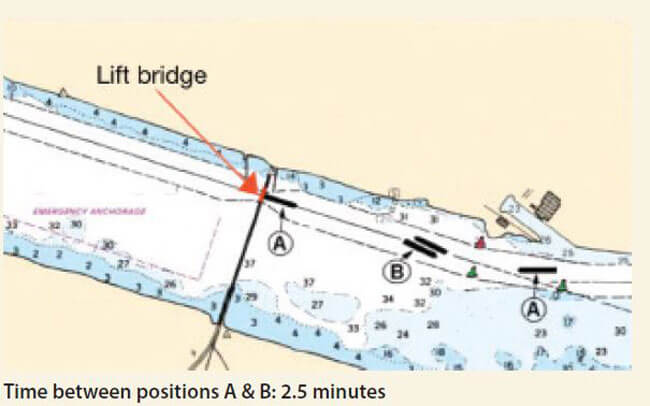In the early morning hours, in darkness and snow squalls, two ships were meeting in a narrow channel. Thirty minutes before the expected meeting, the officer piloting the up-bound vessel called the down-bound vessel to make meeting arrangements; he was to slow his vessel in order to meet below the lift bridge. The officer piloting the down bound vessel agreed, but the exact location of the meeting was not specified. Some time later, as the down-bound vessel passed through the opening of a lift bridge, the up-bound vessel was approaching a turn in the waterway (positions A in the diagram).

The officer piloting the down-bound vessel observed that the up-bound vessel’s aspect seem to indicate a starboard-to-starboard meeting. He called the up-bound vessel on VHF radio to confirm meeting arrangements. The call was delayed 10 to 15 seconds due to radio traffic, but when the up-bound vessel’s piloting officer replied, he stated that they were coming to starboard in preparation for a port-to-port meeting.
Once port-to-port was confirmed, the officer piloting the down-bound vessel ordered hard starboard and increased speed to help kick the vessel’s head to starboard. Meanwhile, the up-bound vessel was coming slowly to starboard. The bridge team of the up-bound vessel could distinguish some of the down-bound vessel’s deck lights through the snow squalls, but Christmas lights on its bow made its aspect difficult to determine. Soon after, the officer piloting the up-bound vessel ordered hard starboard and requested full ahead on the main engine to help kick the bow to starboard. The two vessels nonetheless touched as they passed each other (position B) but avoided major structural damage.
Lessons learned
– Good planning and clear communication is important, even if it is done ‘on the fly’. In this case, the officer piloting the down-bound vessel agreed to meet ‘below the bridge’, but the exact location of the meeting was not specified. As it was, the vessels met at a location that was less than ideal given the relatively narrow channel width, the turn in the waterway, the prevailing currents, and the limited distance available to properly line up the lift bridge approach for the up-bound vessel.
-Never display lights that could introduce confusion for other vessels in respect of your navigation lights.
Source: marineinsight.com